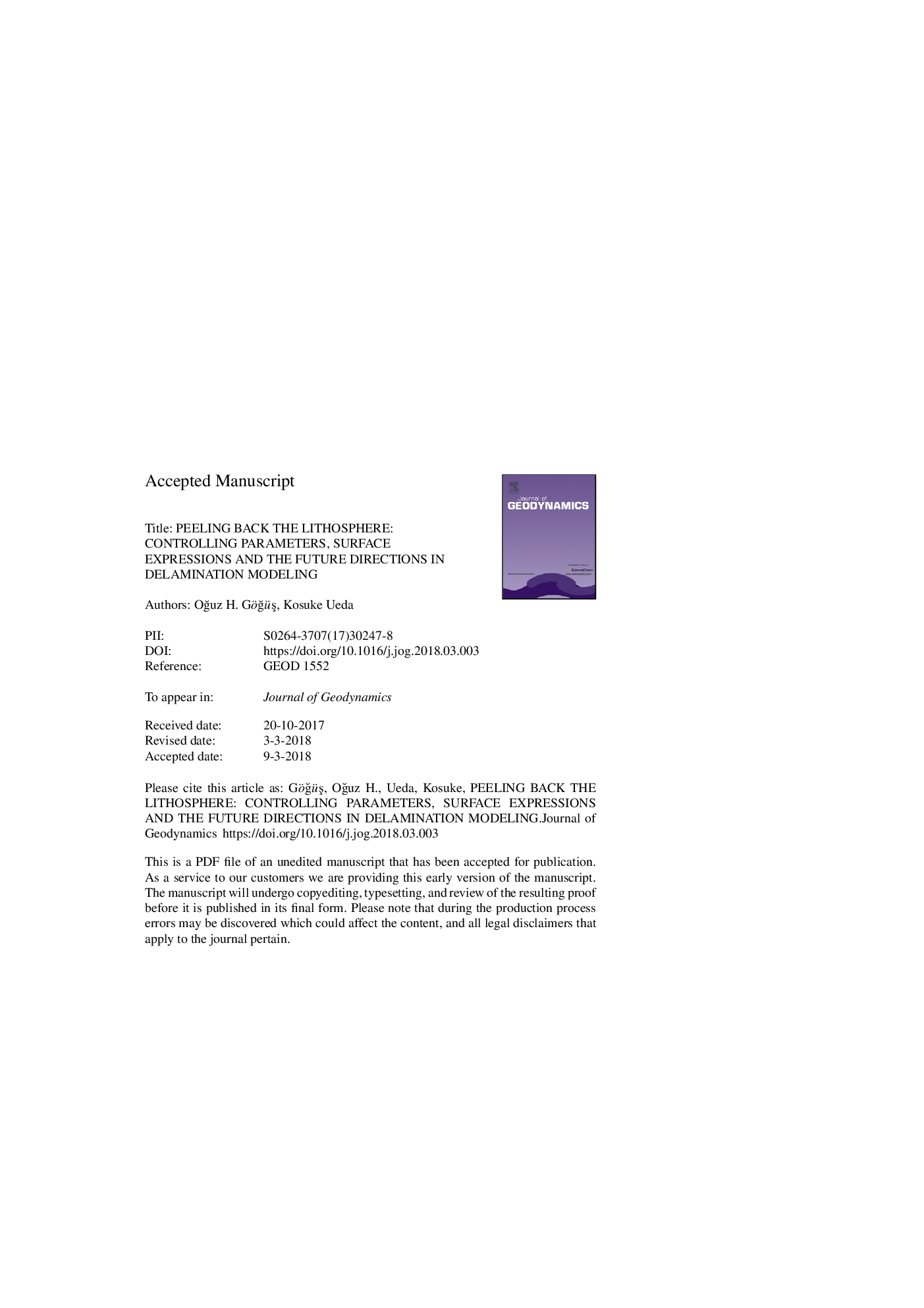| کد مقاله | کد نشریه | سال انتشار | مقاله انگلیسی | نسخه تمام متن |
|---|---|---|---|---|
| 8908406 | 1635733 | 2018 | 73 صفحه PDF | دانلود رایگان |
عنوان انگلیسی مقاله ISI
Peeling back the lithosphere: Controlling parameters, surface expressions and the future directions in delamination modeling
ترجمه فارسی عنوان
لایه برداری پشت لیتوسفر: پارامترهای کنترل، عبارات سطح و جهت آینده در مدل سازی خوشه بندی
دانلود مقاله + سفارش ترجمه
دانلود مقاله ISI انگلیسی
رایگان برای ایرانیان
کلمات کلیدی
خلوص لیتوسفریک، ریمل ژله ساندویچ، مدل سازی ژئودینامیک، پوست پشت و شکسته شدن پوست،
ترجمه چکیده
مدل های ژئودینامیکی خواص رئولوژیکی و فیزیکی لیتوفسفری را بررسی می کنند که پوست را از پوست پوشیده می شود. در همین حال، پیش بینی های مدل برای ارتباط با مجموعه ای از مشاهدات در زمینه زمین شناسی به آزمون اعتبار خلع سلاح استفاده می شود. در اینجا، مدل های عددی و آنالوگ خلع سلاح از این دیدگاه ها را بررسی می کنیم و تعدادی از مضامین مرتب سازی را ارائه می دهیم که مطالعات مدل سازی آینده ممکن است در آن صورت گیرد. مدل ها نشان می دهند که حضور پوسته ضعیف پایین که بین لیتوسفر گوشته گوشته (حداقل 100 بار بیشتر چسبناک / قوی تر) و پوسته قوی قوی برای توسعه خواص خوشه ضروری است. تضعیف پوسته پایین ممکن است با نفوذ نفوذ ذوب، گرمایش برشی یا به طور طبیعی از طریق پروفیل مقاومت نوعی ساندویچ ژله در لیتوسفر قاره رخ دهد. شیب منفی لیتوسفر مورد نیاز برای تسهیل خلع سلاح، از سوی فرآیند پیشرفته اکسیژن و یا اکلوژیتاسیون کوچک کوچکتر الهام گرفته شده است. بیان سطح لیتوسفر پشت لایه برداری یک اثر متقابل و مهاجرت متمایز در پوسته دارد، که موجب افزایش سریع / فروپاشی سطح، ماگماتیسم، گرما و کوتاه شدن / گسترش می شود. نسل جدید آزمایشات ژئودینامیکی می تواند توضیح دهد که چگونه انواع مختلف ذوب (به عنوان مثال، هیدراته، ذوب خشک) رخ می دهد با خواص خوشه بندی. اصلاح لیتوسفر پس از حذف، جنبه های سه بعدی و خاتمه روند، زمینه های تحقیق کلیدی برای تحقیقات آینده است. پیش بینی مدل های قوی، مانند سایر مطالعات مدل سازی ژئودینامیک، باید با مشاهدات سازگار باشد.
موضوعات مرتبط
مهندسی و علوم پایه
علوم زمین و سیارات
فرآیندهای سطح زمین
چکیده انگلیسی
Geodynamical models investigate the rheological and physical properties of the lithosphere that peels back (delaminates) from the upper-middle crust. Meanwhile, model predictions are used to relate to a set of observations in the geological context to the test the validity of delamination. Here, we review numerical and analogue models of delamination from these perspectives and provide a number of first-order topics which future modeling studies may address. Models suggest that the presence of the weak lower crust that resides between the strong mantle lithosphere (at least 100 times more viscous/stronger) and the strong upper crust is necessary to develop delamination. Lower crustal weakening may be induced by melt infiltration, shear heating or it naturally occurs through the jelly sandwich type strength profile of the continental lithosphere. The negative buoyancy of the lithosphere required to facilitate the delamination is induced by the pre-existing ocean subduction and/or the lower crustal eclogitization. Surface expression of the peeling back lithosphere has a distinct transient and migratory imprint on the crust, resulting in rapid surface uplift/subsidence, magmatism, heating and shortening/extension. New generation of geodynamical experiments can explain how different types of melting (e.g hydrated, dry melting) occurs with delamination. Reformation of the lithosphere after removal, three dimensional aspects, and the termination of the process are key investigation areas for future research. The robust model predictions, as with other geodynamic modeling studies should be reconciled with observations.
ناشر
Database: Elsevier - ScienceDirect (ساینس دایرکت)
Journal: Journal of Geodynamics - Volume 117, June 2018, Pages 21-40
Journal: Journal of Geodynamics - Volume 117, June 2018, Pages 21-40
نویسندگان
OÄuz H. GöÄüÅ, Kosuke Ueda,
